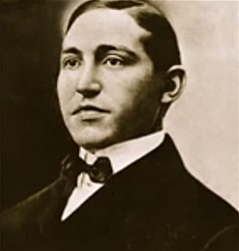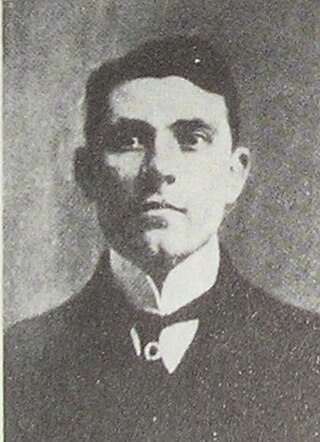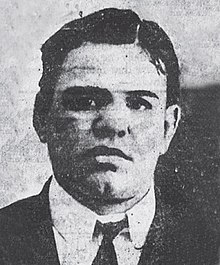
Paul Kelly was an Italian-born American mobster, who founded the Five Points Gang in New York City. He had started some brothels with prize money earned in boxing. Five Points Gang was one of the last dominant street gangs in New York history. Kelly recruited young, poor men from the ethnically diverse immigrant neighborhoods of Lower Manhattan. The Five Points Gang included some who later became prominent criminals in their own right, including Johnny Torrio, Al Capone, Lucky Luciano, Meyer Lansky and Frankie Yale.

"Big" Jack Zelig was an American gangster and one of the last leaders of the Eastman Gang.
The Crazy Butch Gang was an American juvenile street gang active in the New York City underworld during the late nineteenth century. Largely active in Manhattan's Lower East Side, the group were widely known as the cities top pickpockets and sneak thieves during the "Gay Nineties" period. An early member of this gang would later become known as a prominent New York gangster Jack Zelig.

The Five Points Gang was a criminal street gang, initially of primarily Irish-American origins, based in the Five Points of Lower Manhattan, New York City, during the late 19th and early 20th century.

The Whyos or Whyos Gang, a collection of the various post-Civil War street gangs of New York City, was the city's dominant street gang during the mid-late 19th century. The gang controlled most of Manhattan from the late 1860s until the early 1890s, when the Monk Eastman Gang defeated the last of the Whyos. The name came from the gang's cry, which sounded like a bird or owl calling, "Why-oh!"

Edward "Monk" Eastman was an American gangster who founded and led the Eastman Gang in the late 19th and early 20th century; it became one of the most powerful street gangs in the city. His aliases included Joseph "Joe" Morris, Joe Marvin, William "Bill" Delaney, and Edward "Eddie" Delaney. Eastman is considered to be one of the last of the 19th-century New York City gangsters who preceded the rise of Arnold Rothstein and the Jewish mob. Later, more sophisticated, organized criminal enterprises also included the Italian American Cosa Nostra.

Max Zweifach also known as "Kid Twist" and occasionally referred to as Zwerbach was an American gangster active in the early 1900s.
Richard Fitzpatrick was a top gunman in the Monk Eastman gang in New York City. He had defected from the Five Points Gang in the early 1900s; he was active during the late 1890s until his murder in 1904.
The Gas House Gang was a New York City street gang during the late nineteenth century.
Philip "Red Phil" Davidson was an American criminal and underworld figure in New York City during the early 20th century. A known associate of Jack Sirocco, a lieutenant in Paul Kelly's Five Points Gang, he was responsible for the 1912 murder of Eastman Gang leader "Big" Jack Zelig, though at the time of his arrest police were unable to find a police record.

James T. Ellison, better known as Biff Ellison, was a New York City gangster affiliated with the Five Points Gang and later a leader of the Gopher Gang. He was noted for his propensity for physical violence as well as a dapper appearance that led The New York Times to describe him as "looking like a prosperous banker or broker" and contemporary chroniclers as "smooth-faced, high-featured, well-dressed, a Gangland cavalier" and "a fop in matters of dress".

Louis "Louie the Lump" Pioggi was an American criminal and member of the Five Points Gang, known most prominently for the murder of Eastman Gang leader Max "Kid Twist" Zwerbach and Vach "Cyclone Louie" Lewis. He appears in newspaper accounts and public records as Louis Poggi.
Julie Morrell or Jules Morello was an American freelance gunman associated with the New York Eastman Gang around the start of the 20th century. He was hired by Jack Sirocco and Chick Tricker to murder Eastman leader Jack Zelig, who had been engaged in a gang war over control of the Eastmans. However, upon being informed by local saloonkeeper Ike the Plug to whom Morell had bragged "I'll fill that big Yid so full of holes he'll sink !", Zelig lured the unsuspecting assassin to a Second Avenue dance hall, the Stuyvesant Casino, where the Boys of the Avenue were holding an annual grand ball on December 1, 1911.
Giovanni de Silvio or Jimmy Kelly was an American saloon keeper, political organizer and underworld figure in New York City during the start of the 20th century. He was the owner the Fourteenth Street saloon The Folly as well as the popular Mandarin Cafe in Chinatown, located in the notorious "Bloody Angle" along Doyers Street, and was a hangout for politicians, gang leaders and other noted criminals of the era. His cafe was also the scene of several violent incidents, especially during the Tong War, which included, in 1910, the fourth attempted suicide of Chinatown character John "Dippy" Rice and the 1912 murder of Hen Ken Yum, the latter a high-level member of the On Leong Tong and a lieutenant of Mock Duck.
John Lewis (died April 1, 1910), better known by his alias Indian or Spanish Louie (Lewis), was an American criminal and member of the Humpty Jackson Gang, serving as the gang leader's longtime lieutenant from around the turn of the 20th century until his murder in either 1900 or 1910. His death was the first recorded use of a drive by shooting as a means of gangland execution in New York City.
"Big" Jack Poggi or Pioggi was an American saloon keeper and underworld figure in New York City at the start of the 20th century. His bar was the scene of a legendary gang fight in 1912.
Vach "Cyclone Louie" Lewis was an early New York gangster and member of the Eastman Gang under Max "Kid Twist" Zwerbach.
Jack Sirocco (1882–1954) was a New York City gangster involved in labor racketeering and strikebreaking. Originally a lieutenant in Paul Kelly's Five Points Gang, where he was the immediate boss of Johnny Torrio, Sirocco defected to the rival Eastman Gang, which he led in its last days.
Frank "Chick" Tricker was an American gangster in New York who, as a member of the Eastman Gang, served as one of its last leaders alongside Jack Sirocco.
This is a list of organized crime in the 1900s, arranged chronologically.









